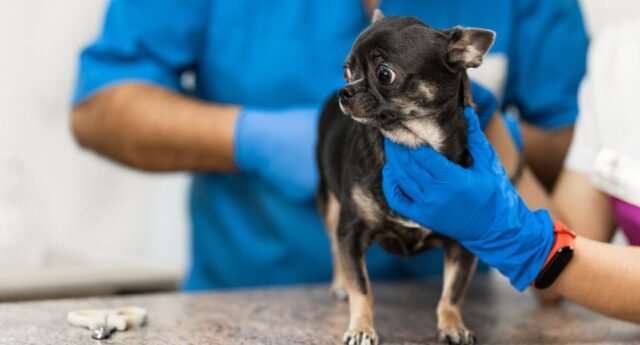
Table of Contents
Is your dog having discomfort in the anus area? Or has he recently been scooting across the floor all of a sudden?
You better have him check out; these can be signs of anal gland cancer in dogs!
If you've ever seen your dog scooting their rear end across the living room, they are probably just trying to empty their anal sacs.
Dogs, cats, and other animals have anal sacs, but humans don't.
Anal sacs, also known as anal glands, are like small balloons filled with a brownish-grey liquid known for its unpleasant, fishy smell.
Dogs have two anal glands that sit inside their anus.
When a dog defecates, some of the fluid in the anal sacs is released with the feces.
This specific fluid is also often produced and released during stressful circumstances. It can also be used in territorial marking and communication between dogs.
This blog will discuss everything you need to know about anal gland cancer in dogs.
Below, we'll talk about what is anal gland cancer, its symptoms, treatment, and more.
Without further ado, let's get things started!
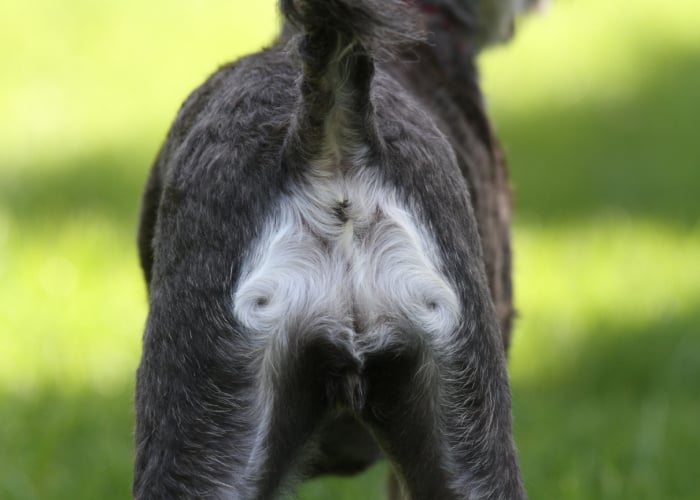
What Is Anal Gland Cancer in Dogs?
As the name suggests, anal gland cancer in dogs is a malignant tumor that develops on a dog's anal glands.
About 2% of all canine tumors are caused by it.
The scent glands also produce and release a specific fluid that serves a role in dog territory marking.
Unfortunately, cancer can develop within these glands.
These invasive and aggressive tumors are often identified as a mass in the anal region.
Canine anal tumors have many names that refer to the same type of cancer.
It is also called:
- Apocrine gland anal sac adenocarcinomas (AGASACA)
- Anal gland carcinoma
- Anal gland adenocarinoma
- Anal sac carcinoma
- Anal sac adenocarcinomama
Apocrine gland anal sac adenocarcinoma, or AGASACA, is the most common type of anal gland cancer in dogs.
These tumors are usually found only in one anal sac, but both sides can occasionally be affected.
Anal gland tumors in dogs tend to metastasize early and spread to other body parts, such as regional lymph nodes and the liver. However, anal gland tumors can also spread to their lungs.
On the other hand, anal gland adenocarcinoma can also damage a dog's kidneys and can even have high blood calcium.
Causes of Anal Gland Cancer in Dogs
Similarly to humans, the cause of cancer is sometimes unknown since it's not always easily found.
But what we do know is that anal gland cancer is found in both male and female dogs, and in adult to middle-aged dogs.
Unfortunately, there are also specific dog breeds that are more prone to anal gland cancer.
For instance, some reports say spaniel dog breeds, such as the English Cocker Spaniel, Cavalier King Charles Spaniel, and the English Springer Spaniel, are more at risk for Apocrine Gland Adenocarcinoma.
In addition, anal gland cancer is also commonly found in German Shepherds, Alaskan Malamutes, and the Dachshunds.
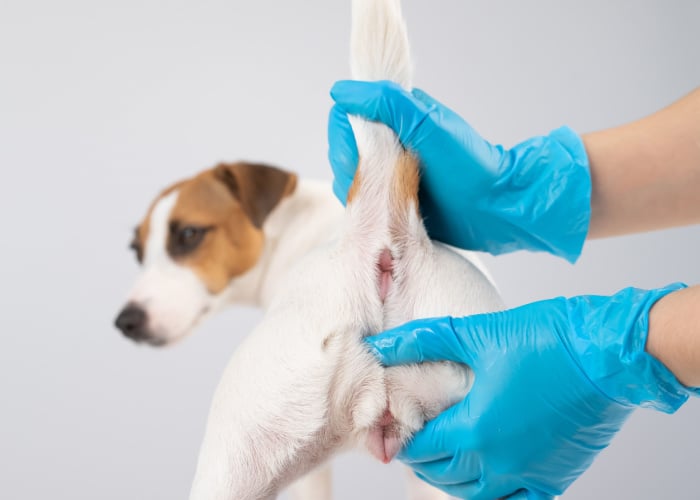
Symptoms of Anal Gland Cancer in Dogs
Sometimes it's hard to notice the signs of anal gland cancer in dogs. Some signs can be in the form of swelling or a growth in a dog's perianal area.
Another possible symptom is when there's a sudden change in the dog's stools.
Below is a short list of symptoms of anal gland cancer in dogs:
Symptoms of anal cancer in dogs include:
- Discomfort and excessive licking around the anus (perianal area)
- Lump beside the anus
- Anal discharge
- Scooting his rear end on the ground
- Straining or difficulty passing poop
- Blood in stools
A tumor that is large enough can look like a swelling in the anal region. It will also make it difficult for them to pass feces or can cause ribbon-shaped stool.
As discussed above, about 25% of dogs suffering from Anal gland adenocarcinoma also have elevated blood calcium levels.
Elevated calcium levels are dangerous to dogs as they can also lead to kidney failure.
If a dog is high in calcium, it can cause an increased thirst and urination. It can also decrease their energy levels and lack of appetite.
Diagnosis of Anal Gland Cancer in Dogs
Anal gland cancer will be hard to detect by yourself.
The best way to accurately know if a dog is suffering from anal gland cancer is during a routine rectal examination performed by a vet.
The vet will try to find or feel a mass during a rectal exam or notice swelling in the perianal area caused by the mass.
To diagnose if your dog has anal gland cancer, the vet will collect cells from the mass through fine needle aspiration (FNA).
Here, a needle (often the same size used in vaccination, don't worry!) will be inserted into the affected gland and used to collect a small sample of cells.
This will be further examined under a microscope to check for evidence of whether it is cancerous or not.
Internal organs appearing abnormal on other diagnostic tests may also be sampled with a small needle.
If the vet still suspects cancer after FNA, they can confirm the diagnosis through biopsy with histopathology, where the vet will need to collect more cells and examine them.
Occasionally, the vet can also recommend doing bloodwork, abdominal ultrasound, and chest X-rays.
With bloodwork, we can see the overall health of the dog's organs, including its calcium levels.
On the other hand, abdominal ultrasound can determine if the cancer has spread to the dog's internal organs and lymph nodes.
Chest X-rays can help the vet see if the cancer has spread to the lungs or neighboring organs. They can detect cancer that has spread to the lungs or other nearby organs.
If your dog has been diagnosed with anal sac cancer, it's best to consult a board-certified veterinary oncologist.
Treatment for Anal Gland Cancer in Dogs
When it comes to cancer, it's best to be detected early and be followed with the proper treatment.
The first option would be surgery.
If the cancer is detected in the early stages and has not spread yet, the complete removal of the tumor is advisable.
And if the cancer has spread to local lymph nodes, the vet will also most likely remove it during surgery.
If the cancer has already spread to the dog's body, surgery will still be performed to help your dog feel more comfortable.
Unfortunately, it will not help increase their life expectancy.
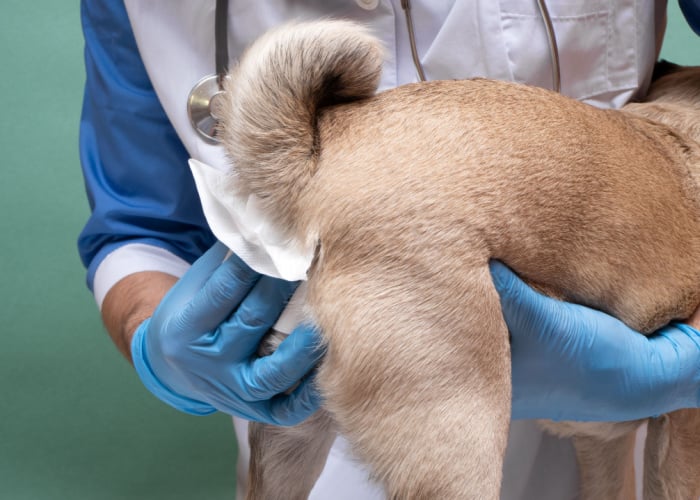
The second recommended step will be Chemotherapy.
Chemotherapy is often recommended for the prevention of the chance of further metastasis.
Another option is to put your dog through radiation therapy.
Radiation may also be required when the mass is not in a good spot for surgical removal.
These additional treatments can help improve your dog's life expectancy.
Vets will also require follow-ups as it is crucial to your dog's health.
Dogs that undergo anal gland cancer surgery will require return visits every three months for 18 months.
And yes, if you're wondering, the recovery from anal gland cancer really does take time.
Frequently Asked Questions
Can dogs survive cancer without treatment?
It will be difficult for dogs to survive cancer without proper treatment.
Untreated dogs have an average survival time of two months from diagnosis.
This can be prolonged with the help of chemotherapy. However, not all lymphomas respond well to chemotherapy.
Is cancer painful for dogs?
Of course, cancer is painful for dogs. Cancer is a painful disease that can cause misery and discomfort to dogs.
Consult your vet immediately if you suspect your dog is ill.
Where does cancer usually start in dogs?
The most common cancer in dogs is Lypmphoma, which originates in the lymphatic system or lymph nodes.
This cancer can spread to the bone marrow and internal organs.
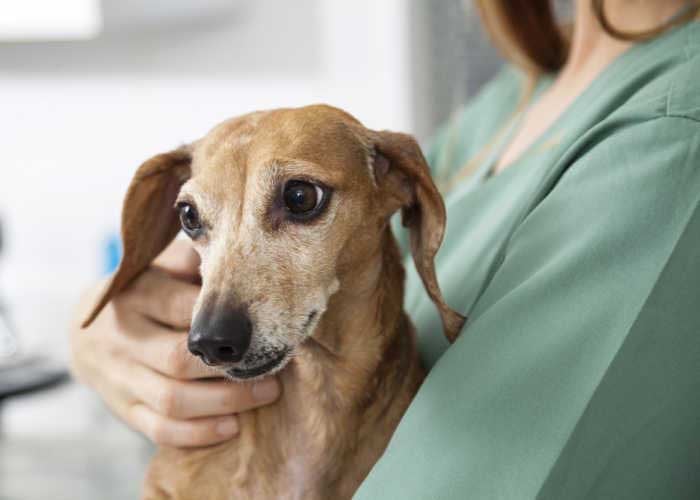
Anal Gland Cancer in Dogs: Before You Go…
Anal gland cancer in dogs, or anal gland adenocarcinoma (scientific name), is a cancer within the dog's anal glands.
Anal glands are small sacs found on the side of the anal opening of a dog. They produce a small amount of liquid released when your dog defecates.
If a tumor develops in this area, it will cause discomfort and pain for your pup.
The cancer can also spread to other body parts and can cause hypercalcemia or elevated blood calcium, leading to kidney damage or failure.
This serious cancer usually forms a mass that your vet can feel during a rectal exam.
Even though the cause of anal gland cancer in dogs is unknown, it is found equally in male and female dogs.
A few signs that your dog might have this cancer are when he is scooting across the floor, excessively licking around the perianal region, straining to poop, and more.
Surgical removal of the anal gland and sac is recommended to treat this. Removing the tumor can help with the dog's recovery and can help them live longer.
If you want to read more cancer-related illnesses in dogs, check out our related articles below!












